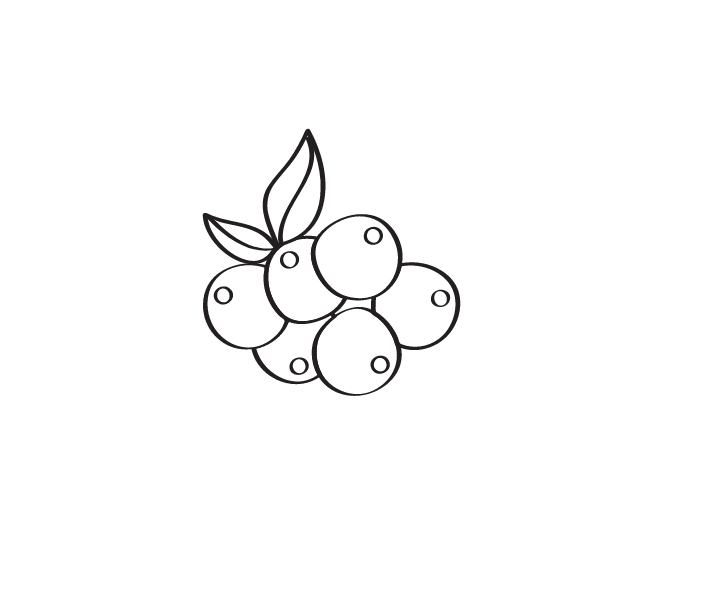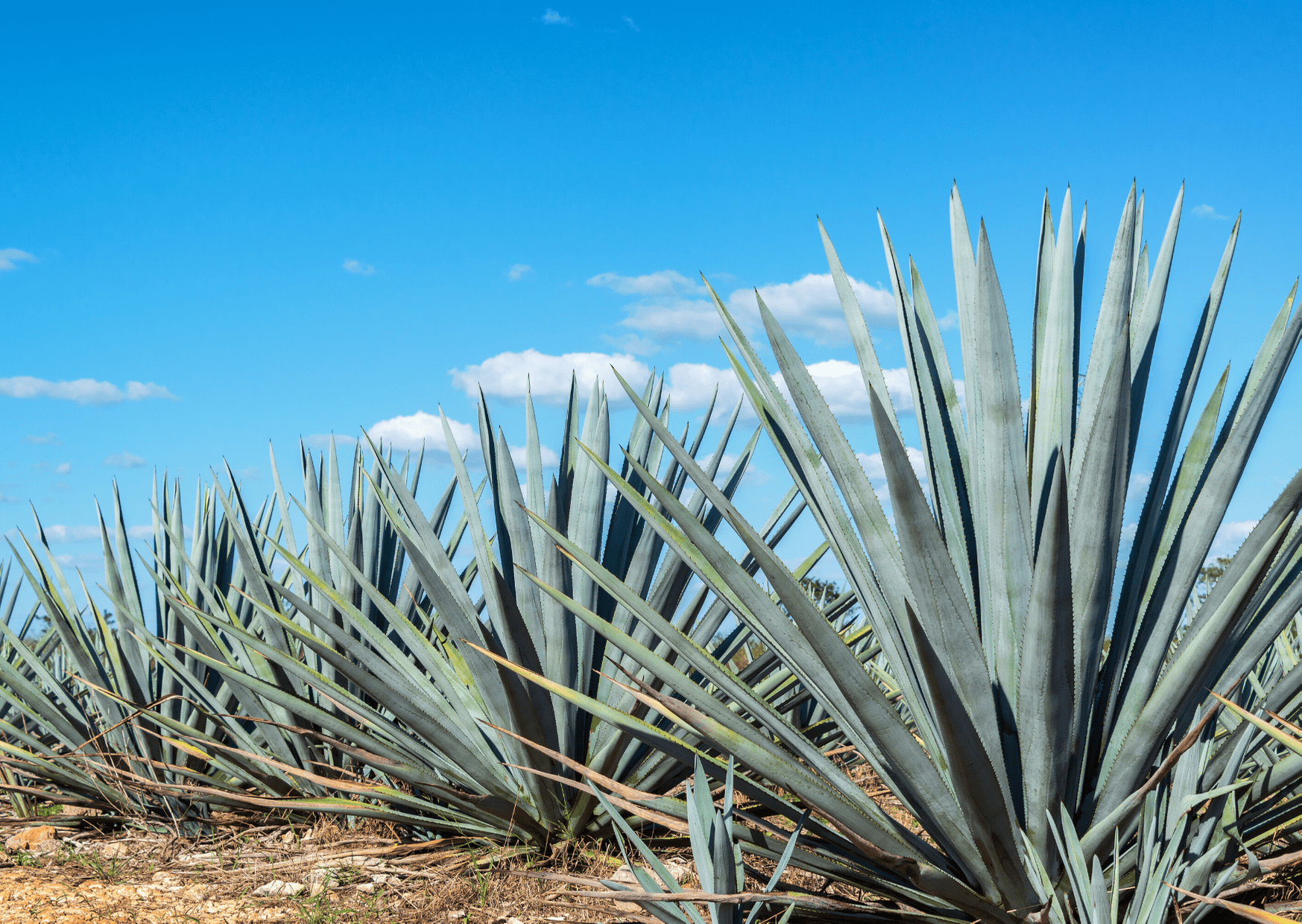
All you need
to know about
spirits made from
agave
in a nutshell
The geography and the history of Tequila
Tequila is protected internationally by a Designation of Origin controlled by an independent body “El Consejo Regulator del Tequila” located in Jalisco. El Consejo has diverse functions, it controls that Tequila is correctly produced, where Tequila is produced (see the map below taken from the official website) and gives the official definition.
Tequila can only be produced in defined areas in the following Mexican states:
Jalisco (all state)
Nayarit (not all state)
Michoacan (not all state)
Guanajuato (not all state)
Tamaulipas (not all state)

Tequila is made with Blue agave
In short, there are over 300 species of agave (around 130 actually grow in Mexico) and let’s be clear, Agaves are not from the cactus family nor related to Aloe Vera or Lilies. Agaves are actually part of the Asparagaceae family.
Agave based spirits are not all made with the same type of agave. Thus, Tequila can only be produced with Agave Rigidiae tequiliana weber var. azul, or the Blue Weber agave.
To learn further about the plant please go and read what Ian Chadwick says about it HERE
Only the hearts, known as piñas are used to make Tequila. The leaves will have other use such as food, fiber, musical instruments and surfboard elements….

The agave growth
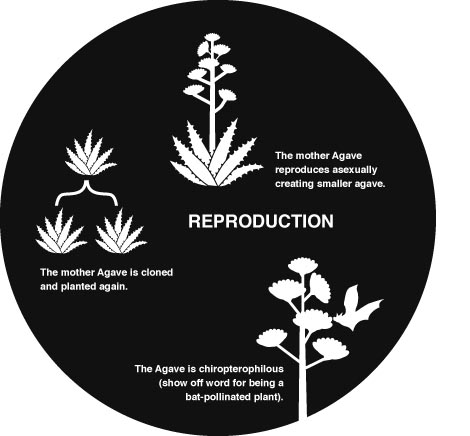
Agaves are plants that are slow maturing and have several reproduction strategies to face the arid conditions in which they grow.
In the sandy hot climates they live in, not so many animals can survive, meaning it is never sure pollination will happen. Agaves do not place all their seeds in one pod that is why they reproduce both sexually and asexually…
You’ll find more about the agave in that article published in the Wired).

The Agaves are regularly trimmed and pruned to force the plant to increase the size of the heart, the piñas, instead of the leaves, flower and shoots and most of all to increase the sugar content of the head. Without trimming the piñas would have quickly large shoots, which would draw the energy and sugar away from the piñas (sugar is needed, not only for taste but to assure fermentation will take place).
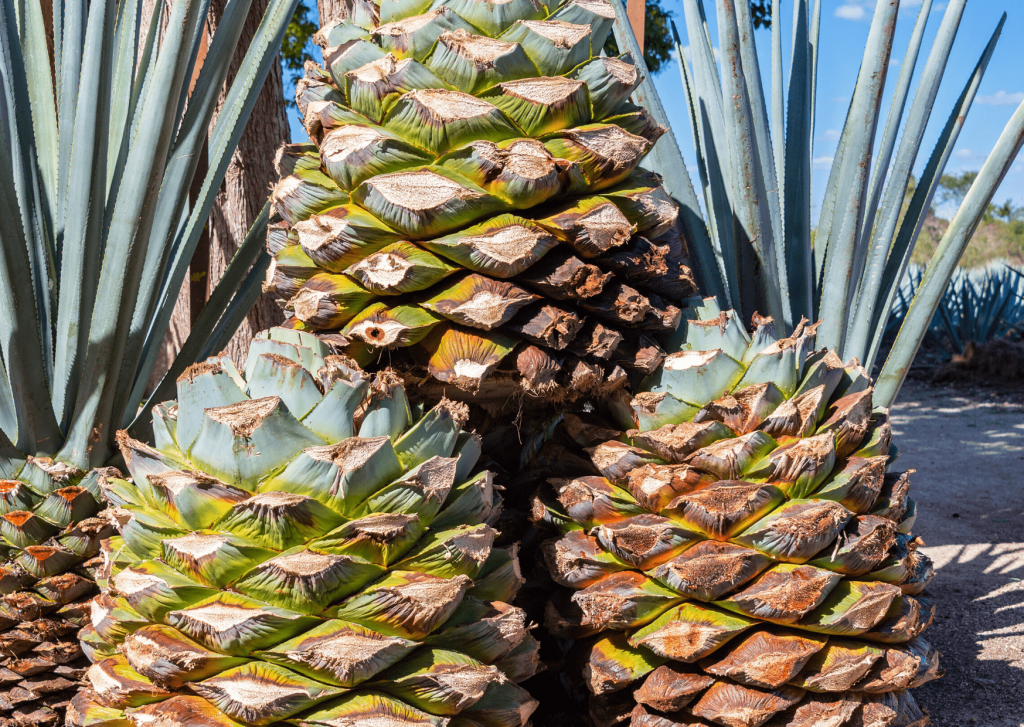
The harvest of the agave
Most agave plants need up to 6 to 10 years to mature but up to 14 for some exception depending of the region, the climatic conditions and the sugar level in the head.
Indeed the size of the agave head (piña) is not as important as its sugar content. The Jimadores’ knowledge and experience is crucial to make sure only the piñas having reached perfect maturity are picked. Technicians test the agaves to be sure the sugar content of the plant is high enough to harvest (at least 24% but higher is preferred).
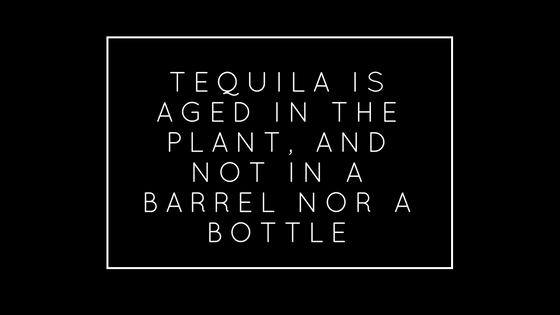
There is a short window of only a few months between the optimum sugar level and the over-ripening of the agave. The best harvesting is at the end of the dry season when the sugar content is at its highest. Last but not least: harvest is done manually.

A great video about harvesting:
Now that the pina is harvested, it has to be cooked
When the piñas arrive at the distillery, they are sliced into sections before being placed in an oven.
Cooking length, style and time in the year will impact the style of Tequila.
3 reasons why pinas are cooked:
1: It transforms or converts the inulin contained in the piñas into fermentable sugar, crucial to start fermentation at a later stage
2: It softens the piñas, which will be easier to mill afterwards
3: It adds aromas that will impact the style of the future tequila
2 ways to cook piñas
They are cooked in ovens, both traditional and modern.
Traditional
Pinas are cooked in traditional brick ovens named hornos. Hornos are traditionally stone ovens and wood fired. The cooking lasts up to 72 hours. The longer and gentler the cooking time the more the piñas soften instead of burning, which impacts the final taste. already during cooking a sap appears, is scooped out and left aside. It will be added in the fermentation tank, possibly.

Modern: Pinas are cooked in large pressure cooker like stainless steel ovens, but using coal or gas, named autoclaves. Here cooking lasts from 12 to 48 hours. The process is way more faster than the traditional one but it has to be very carefully monitor to not overburn the piñas.
After cooking, comes grinding
After the cooking, piñas must rest for up to 2 days to cool down before being sent to grinding. Grinding a.k.a. milling is the action of crushing and shredding the piñas. Again there are modern and traditional ways to proceed.

The more traditional way often involved animal power and an old milling stone. Indeed the piñas are put under a large grinding stone called a tahona often driven by a donkey. As the agave are crushed, the juice sets on top of the fibers.
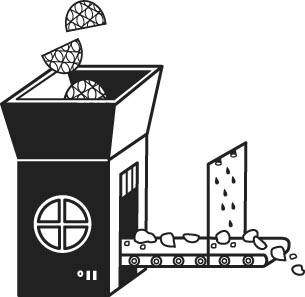
Modern way involves machineries: the piñas are put onto a conveyor belt where they are first sprayed with water before a machine shreds them. The crushed fibers are then steeped with water and drained and it is this resulting liquid that will be later fermented. There is less flavorful elements contained in this liquid.
After grinding, it is time for fermentation

This liquid obtained from the grinding process, together with yeast (natural, commercial or wild) and water are poured together is a vast tank and left to ferment, often in open tanks, without roof (for the most traditional versions). Most of the producers use commercial yeasts. If you want to understand the influence of yeast, you need to read a great article by Ian Chadwick.
Sometime left over fibers from the grinding are put back in the tank to give additional flavors. If one wishes to make a mixto for example, this is also the moment during which non agave sugar will be added.
The resulting liquid is named meuro and this is what will be distilled. It has an abv that can range from 4 to 8%. After fermentation is finished, the must may be left another 12 hours to richen and settle before distillation.
After fermentation comes distilling
Distillation is the process of separating the component substances from a liquid by selective evaporation and condensation. Water is boiling first, evaporates and ethanol being heavier is kept aside and collected, in one go as in the case of continuous stills or in two distillations with a pot still. For Tequila, both pot stills and continuous stills are used, although small scale producers favour pot still.
With a pot still, Tequila is usually distilled twice. The first distillation gives a liquid at 25% abv. named Ordinario and the second distillation gives Tequila which is at 55% abv. Tequila is rarely distilled three times. During distillation, temperature is carefully monitored to avoid flavour spoilage and undesirable smokiness. If a producer plans to age his/her Tequila it will be distilled a bit higer to allow for some evaporation during ageing. If the plan is to make a young full bodied Tequila, then it can be distilled at a lower level and bottled without dillution.
Pure Tequila can’t be drunk straight from the still. It requires some resting time, a producer’s decision as per the style according to percentage of blue agave in the final beverage as well as time spent in oak barrels.
Bottling and diluting
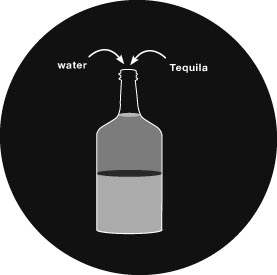
Tequila is bottled shortly after distillation and diluting with water so it is 40 abv.
Styles of tequila

Gold
or Joven. Tequila is usually a Mixto containing coloring and other additives, but 100% Agave Gold also named 100% Agave Oro are a blend of younger and older tequilas.

Mixto
Mixto are made by fermenting and distilling a mix of Agave juice and other sugars, usually cane sugar with water. Any Tequila that is not labelled “100% Agave” is a Mixto, and most likely is almost half cane sugar, regardless of any other labelling.

Plata = Blanco = Silver: 1 month in oak
It is generally unaged Tequila and a clear spirit. It is bottled immediately or shortly after distillation and dilution.
100% Agave Tequila
Within this category, according to the time spent in oak, different styles of maturation are available: blanco, reposado, anejo, and extra anejo (see below). By law 100 % Agave Tequila must be bottled in Mexico.

Reposado: maturation of a minimum of 2 to 11 months in oak
The barrels are most of the time ex-bourbon barrels, which gives flavours of caramel, toast and some vegetal notes. The ageing also imparts colour to the Tequila and softens it.

Añejos: maturation of a minimum of 1 year in oak vats or barrels.
The barrels are often American oak barrels, which give even more depth in the character as well as more caramel, vanilla, toast and even hints of sweet spice.

Extra-añejos: maturation of a minimum of 3 years in oak barrels.
Mezcal
Where mezcal and tequila differs:
Different base material
Tequila can only be made with Blue Agave, many species are authorized by the DO of Mezcal.
Different geography
Both Mezcal and Tequila are DO, protected designation of origin and can only be produce in certain states of Mexico.
1. Tequila is made in 5 specific regions: Jalisco, Michoacan, Guanajuato, Nayarit, and Tamaulipas.
2. Mezcal is made in 8 specific regions of Mexico: Oaxaca, Durango, Guanajuato, Guerrero, San Luis Potosi, Tamaulipas, Zacatecas, and the recently approved Michoacan.
3. 3 states overlap and make both tequila and mezcal: Guanajuato, Tamaulipas, Michoacan
Different production process
Mezcal is often more artisanally produced than Tequila.
A tequila harvest and a Mezcal harvest is essentially the same (with different varieties of agave). How the piñas are cooked is where the process start to differ.
Indeed, in most instances Mezcal producers use the centuries old method of baking the agave in an underground, earthen pit. The pit is typically about 5 meters wide and 2 meter deep, and cone shaped down to the bottom. It is lined with rock. There are indeed a wide diversity of fire techniques, depending of the ingeniosity or commitment of the Mezcalero. Generally, a fire is started in the bottom with wood. This fire heats the rocks to extreme heat. The piñas are then quickly piled into the pit and covered with about a foot of earth, topped with a necessary chimney. This underground “oven” smokes, cooks and almost caramelizes the piñas. This is where Mezcal gets its earthy and smoky flavours.
The way the pinas are ground is often different.
Once roasted, the piñas are crushed in old-fashioned stone wheel pulled by horse or donkey. It’s all very artisanal.
Most of the tequila will go through shredding/grinding machine.
The length of fermentation and the use of indigeneous yeasts for Mezcal vs commercial for Tequila consitute another difference. There are of course exceptions, and sometimes a Mzcal can be more “industrial” than a Tequila.
A last difference lies in the distillation process; more pot stills or Filipino stills are used for Mezcal than for Tequila.

Other agave based beverages
Raicilla
Raicilla, like Tequila comes from Jalisco and more particularly from 7 cities of the area of Puerto Vallarta, by the Pacific Coast. Raicilla is made where Tequila is made BUT Raicilla is not made from the Blue Weber agave, so it cannot be called Tequila.
Raicilla is made from the agave pata de mula (Agave maximiliana) & the agave lechuguilla (Agave inaequidens).
Contrary to Bacanora, Raicilla does not have a DO however the Mexican Council of Raicilla Promoters was founded late 1990s.
Read this ARTICLE to go a bit further.
Pulque
Pulque is a very ancient drink from Mexico. It is fermented and not distilled.
It has low ABV (as much alcohol as in beer). It is made from specific types of Pulque Agave (Agave Salmania, Agave Americana, Agave Weberi, Agave Compicate, Agave Gracilipes, Agave Melliflua, Agave Crassispina, Agave Atrovirens, Agave Ferox, agave Mapisaga, Agave Hookeri).
Pulque is made from cutting the leaf of the agave, and letting a sappy juice (aguamiel) to leak out and gathering into open wood barrel for fermentation.
Pulque is always served very fresh. After one day, as yeasts and bacteria in the pulque are still active, taste changes strongly (and not good anymore). Pulque, when fresh, is full of nutrients (vitamin B, C, iron, etc). That is why Pulque in can must be AVOIDED. Pulque has a sour taste, slightly like ripe pear or banana & has the color of milk.

Bacanora
Bacanora is a Mezcal that can only be made in the state Sonora (north west of Mexico). It is a DO.
Bacanora is named after a town in Sonora (just like Tequila is named after a town in Jalisco).
It is distilled from the fermented juice of an agave named Yaquiana (A. angustofolia).
Bacanora has its own D.O. since November 2000 and can be named as such only if it contains 100% of this wild agave (compared to Tequila, a Mezcal that only require 51% of Blue Agave).
Bacanora is regulated by a Consejo Sonorense Regulador del Bacanora.
If you understand spanish, a cool film about Bacanora to watch on You Tube: HERE
Pechuga
Pechuga is an old Mezcal technique wich varies from producer to producer and is most of the time only produced in tiny amounts for personal consumption. It is made by redistilling a finished mezcal with a mix of wild, seasonal fruits, often grains and always a raw, skinless chicken breast. As the chicken breast is suspended in the distillation process, the steam cooks through the chicken. I is said that the chicken’s fat and proteins help soften the smokyness mezcal. The addition of wild fruit helps, too 🙂
Sotol
Sotol was said to be a Mezcal for a long time but as it is produced solely from the Sotol plant (a.k.a. Dasylirion wheeleri) which is now classified as a member of the Nolinaceae family, Sotol is NOT made from an agave, therefore, not technically a mezcal.
However it has been in this category for so long, that we leave it that way here….
So Sotol is made from desert spoon, a plant similar to agave that grows in the northern Mexican states of Chihuahua, Coahuila and Durango. And it can only be produced in the Northern Mexican States of Chihuahua, Coahuila, and Durango
It grows at higher and therefore cooler altitudes than Mezcal and Tequila. It reaches maturity at around 10/15 years but pinas are 1/3 of the size of the blue agave.
Sotol is made from 100% Sotol, no mixto are produced.
Some Sotol are aged in barrel, under the same categories than Mezcal and Tequila (blanco, reposado, etc). Sotol has a Mexican denomination of origin since 2004.
All illustrations are by Ana Briceno















